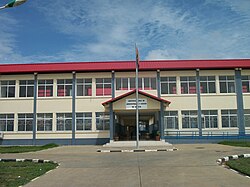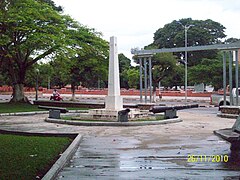Luena (Angola)
| Luena | ||
|---|---|---|
|
|
||
| Coordinates | 11 ° 47 ′ S , 19 ° 55 ′ E | |
| Basic data | ||
| Country | Angola | |
| Moxico | ||
| Município | Luena | |
| ISO 3166-2 | AO-MOX | |
| Comuna | Luena | |
| height | 1350 m | |
| Residents | 456,000 (2014) | |
| politics | ||
| mayor | Bento Luembe Paulino | |
|
The Instituto Médio de Administração e Gestão administrative school in Luena
|
||
Luena (also Lwena ) is a city in eastern Angola . At the time of the Portuguese colonial rule until 1975, the place was called Vila Luso or Luso for short . It is the capital of the province of Moxico and the seat of the Diocese of Luena .
climate
Luena has a warm temperate climate. Winter is much drier than summer. The humidity is relatively high in summer.
| Luena | ||||||||||||||||||||||||||||||||||||||||||||||||
|---|---|---|---|---|---|---|---|---|---|---|---|---|---|---|---|---|---|---|---|---|---|---|---|---|---|---|---|---|---|---|---|---|---|---|---|---|---|---|---|---|---|---|---|---|---|---|---|---|
| Climate diagram | ||||||||||||||||||||||||||||||||||||||||||||||||
| ||||||||||||||||||||||||||||||||||||||||||||||||
|
Average monthly temperatures and rainfall for Luena
Source: climate-data.org
|
||||||||||||||||||||||||||||||||||||||||||||||||||||||||||||||||||||||||||||||||||||||||||||||||||||||||||||||||||||||||||||||||||||||||||||||||||||||
history
The old Soba (German: chief) Moxico had his residence here when the expedition of the Portuguese travelers to Africa Serpa Pinto and Silva Porto arrived here in 1894/95. She built a first fortress here. Based on the findings of the expedition, the Moxico district was established on September 15, 1917, named after the local regent. The expedition lieutenant Trigo Teixeira set up the first district administration here in 1918. Moxico's first governor, Dr. António de Almeida, had the new district capital built 20 km north of the town, between the Luena and Lumege rivers. He called it "Moxico Novo" (New Moxico). In 1922 General Norton de Matos traveled to Moxico Novo for the first time as High Commissioner of Angola. Then he made the growing town into a small town ( Vila ) and named it "Vila Luso", based on the Portuguese town of Luso . On May 18, 1956, Luso was elevated to a city ( Cidade ). After Angola gained independence in 1975, the city dropped its Portuguese place name and has since borne the name of the nearby river Luena . After this, the Luvale people in Angola are also called Luena.
On April 4, 2002, the Angolan government and the rebels of UNITA signed the Luena Memorandum of Understanding here , which ended the civil war in Angola , which had been going on since 1975 . Shortly before, the rebel leader Jonas Savimbi had been murdered not far from Luena.
administration
The circle
Luena is the seat of a district of the same name ( Município ) in the province of Moxico .
The Luena district is made up of four municipalities (Comunas):
- Cangumbe kachipoque
- Lucusse
- Luena
- Lutuai (also Muangai)
The urban area of Luena, in the municipality of Luena, has grown significantly due to returning civil war refugees. The predominantly uncontrolled growth produced a number of new city districts. These include Nzaji, Saidy - Mingas Popular, Mandembué, Zorrô, Santa Rosa, Sinai - Velho, Aço and Kapango, and others. a.
population
Estimates of the population of Luena varied for a long time between 60,000 and 200,000 people, Bevölkerungsstatistik.de gives as much as 85,000 for 2010. An unknown number of internally displaced persons (30,000 to 60,000) fled the Angolan civil war to Luena.
Most recently, the population has risen sharply due to the massive influx of returning civil war refugees. The state news agency ANGOP last stated 456,000 residents for the district. The 2014 census showed the Município 357,413 inhabitants. The estimate for 2019 is around 415,000.
Sights and culture
Luena has few attractions, including the main church Igreja Nossa Senhora das Vitórias (English: Church of Our Lady of Victories). In September, numerous festivities take place in the surrounding rural areas to mark the circumcision of adolescent males.
A memorial was erected in the chessboard-like city to commemorate the negotiated end of the civil war. The rebel leader Jonas Savimbi , who was previously murdered near Luena, is buried in the city's central cemetery ( cemitério central ).
Outside the city is the protected forest area Reserva Florestal do Luena , which is threatened by the recent strong growth of the city.
Parque Nacional da Cameia
The Kameia National Park consists mostly of wetlands and was designated as a protected hunting ground in 1935 before becoming a national park in 1957 . With an area of 14,450 km² it is one of the largest of the nine official national parks in Angola .
The park is bounded to the east by the Zambezi , to the south by the Luena, and to the west and north by the Benguela Railway. The most important mammals of the park are the wildebeest , the Topi ( Tsebesse ), the lechwe ( lechwe ), the reedbuck ( Chango ), the desert warthog ( Javali ), the lion ( Leão ) and other big cats.
Sports
The football club Bravos do Maquis , founded in 1983, plays in the highest Angolan league, the professional league Girabola . He welcomes his guests in the Estádio Comandante Jones Kufuna Yembe - Mundunduleno , also known as Estádio do Luena , with a capacity of 4,300 . The soccer club Juventude de Moxico is also at home there . In 2007 he played one season at Girabola.
traffic
Luena is located on the Benguela Railway between Huambo and Luau near the border with the Congo. The main road connection is the overland road to Kuito in the west and to Luau in the east. It is one of the connecting roads in the country that has not yet been built and is in extremely poor condition (as of 2012). Therefore, there are only a few transport options available from Kuito, which are limited to motorcycle taxis (Motos), heavy off-road vehicles and the KAMAZ trucks, and are relatively expensive. Luena Airport has a. a. via daily connections to the capital Luanda. The airport, at an altitude of 1329 meters, has the IATA airport code LUO and the ICAO code FNUE.
sons and daughters of the town
- Henrique Nascimento Rodrigues (1940–2010), Portuguese lawyer and politician, Minister of Labor 1981
- Luísa Coelho (* 1954), Portuguese linguist and writer
- Luis Quintais (* 1968), Portuguese anthropologist and poet
Web links
- Report on Luena in the Civil War
- Profile of Luena County on the 2014 Census Official Website
Individual evidence
- ↑ a b c d Article from May 18, 2014 on the 58th anniversary of Luenas , state news agency ANGOP , accessed on May 18, 2014
- ^ The end of the war: the Luena Memorandum of Understanding
- ↑ bevölkerungsstatistik.de ( Memento of the original dated December 29, 2011 in the Internet Archive ) Info: The archive link was inserted automatically and has not yet been checked. Please check the original and archive link according to the instructions and then remove this notice. (2007)
- ↑ Population statistics ( memento of the original from July 13, 2019 in the Internet Archive ) Info: The archive link was inserted automatically and has not yet been checked. Please check the original and archive link according to the instructions and then remove this notice. citypopulation.de , accessed on June 16, 2019.
- ^ Joost De Raeymaeker: À Descoberta De Angola . 1st edition, Verlag LeYa , Alfragide 2012, p. 232ff and p. 17 ( ISBN 978-989-741-009-3 )
- ↑ Website of the Angola Natural Parks (port.), Accessed on December 12, 2013
- ^ Joost De Raeymaeker: À Descoberta De Angola . 1st edition, Verlag LeYa, Alfragide 2012, p. 233f ( ISBN 978-989-741-009-3 )




